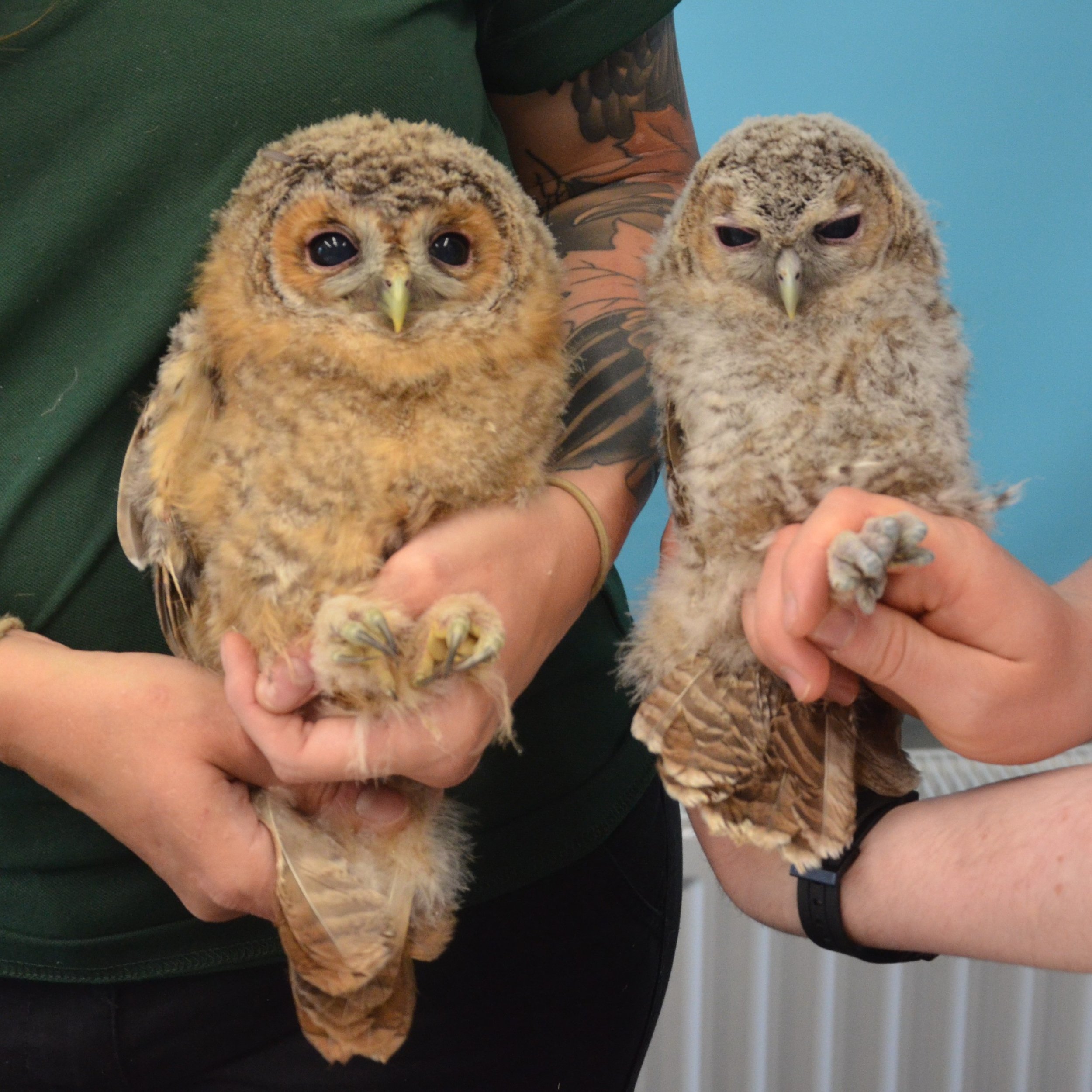This year we’ve seen an unprecedented number of Tawny Owlets need assistance form us! It seems that no sooner do we invite Dr Hugh Hanmer to come and ring the birds we have ready for release, more come in!
Hugh recently came down to supervise Jess and Susan ringing four young Tawny Owlets, plus a young Little Owl to add some variety.
The first one to be ringed was taken to vets after being found in the middle of a field being attacked by crows. This was an older chick, who was already pretty well feathered but with no indication where they came from, they w ere brought in to be assessed, After a day under observation in case of any injuries, they were put in our large outdoor aviary with the other Owlets to assess flight and balance. As soon as they were released, this Owlet flew a few laps of the aviary, then perched on a branch and proceeded to call repeatedly.
Little and Large! Two Tawny Owlets currently in our care.
When this one was ringed, we suspect that they might be a female, due to her size and aggressive nature. Nicknamed Giant Ginger by the team, because of her gorgeous gingery plumage, she was significantly larger than the other Owlets in the aviary. We took the decision to move her to our Hack Pen at the Food Museum in Stowmarket, with the two older chicks from earlier in the season, and she has settled in well with them. These three will soon have the hatch opened so that they can venture out into the wild.
“Giant Ginger” has unusually reddish feathers
The second Owlet to be ringed was the youngest, having been found around 2 weeks of age after a period of wet weather. It was far too young to be out of the nest and was weak and disorientated.
This young Owlet wasn’t too impressed by the ringing procedure
The third to be ringed was found by a cyclist and brought in by one of our Owlreach volunteers. This was also the producer of the massive Pellet which caused much excitement when it was dissected.
This Owlet showing off it’s new ring - this is a unique alpha numeric code which means that if this Owl is found again after release, we will be notified
The fourth was found on someone’s drive but with no nearby woodlands nearby was deemed necessary to bring it in to us.
Ringing requires specialist equipment and training. Education Officer Susan is close to having Owls added to her ringing permit.
These three Owlets remain at SOS for now with Bill, but will soon be relocated to a couple of hack sites nearby. We try to choose sites where there is plenty of habitat to avoid too much competition with resident birds. Unfortunately, with good quality woodlands at a premium locally, it is inevitable that our release sites may be part of an existing territory. However, we generally find that adults are more tolerant of youngsters and that once the young Owlets have had time to adjust to life in the wild, they soon disperse and find a new place to live.
The Little Owl was found in the middle of a road and brought in as it was thought it may have been hit by a car. After being checked over it was found to be dehydrated so was kept under observation for a couple of days. It was reluctant to eat initially but after some perseverance from our team, decided it quite liked the taste of mouse and was soon eating by itself. This youngster had likely fledged from nearby and was unfortunate to find itself near a road. It will be returned for release near where it was found, but well away from the road!
Little Owls require smaller rings which can be a bit more fiddly to fit.
Later that day, after Hugh had left, we had another Tawny Owlet come in, followed by another one the next day! This brings us up to 9 in total so far this year!
Susan enquired amongst other ringers and the general nationwide thoughts are that Tawny Owls had a very successful breeding season last year, so this year there are more adults attempting to breed in sub-optimal sites. Add to this the fact that locally we are aware of many established woodlands that were hit by the storms and lost several old trees, and it would suggest that Tawny Owls are simply struggling to find suitable places to nest.
If you’d like to help, you can find details on how to build an Owl box here.






